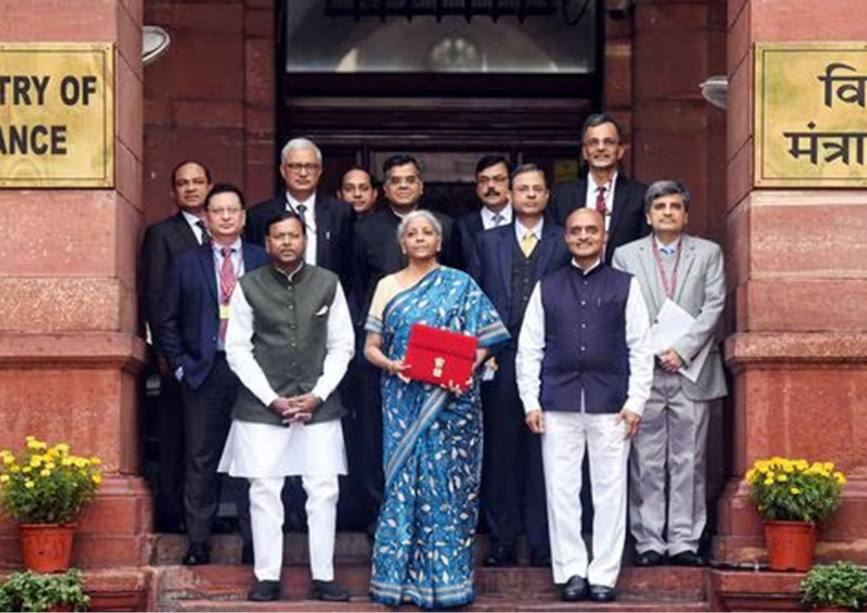-
CENTRES
Progammes & Centres
Location
Under the Interim Budget, the Financial Minister has outlined a few schemes for urban development, but a more comprehensive budget would be required for major policy decisions

In the Budget Speech to the Parliament, India’s Finance Minister (FM), Nirmala Sitharaman, rolled out the Budget for the financial year 2024-25 on 1 February 2024. Given the imminent national elections expected to be scheduled in the first half of the current year, the scope of the budget got restricted to an interim one, also referred to as ‘vote on account’. Such a budget serves the prime purpose of keeping essential operations funded. The more comprehensive version would have to await the elections and the subsequent formation of a new government that could present the full, unrestrained budget with major financial and policy decisions. In the given background, it was natural for the FM to spend considerable time detailing the achievements of the current national government since it came to power. She also provided a fleeting glimpse of what could come if this government returned to power.
The more comprehensive version would have to await the elections and the subsequent formation of a new government that could present the full, unrestrained budget with major financial and policy decisions.
This article recounts and analyses what the Budget asserted regarding cities and what was outlined for them for the future. At the national scale, the FM claimed that there was a ‘profound positive transformation’ in the Indian economy in the last decade. This fundamental change was a result of, among other factors, structural reforms, pro-people programmes, and the creation of larger opportunities for employment and entrepreneurship. Furthermore, the period was marked by a focus on social inclusivity with programmes of housing for all, water for each house, cooking gas for all, bank accounts and financial services for all and free ration for 80 crore Indians. These initiatives resulted in 25 crore people being pulled out of multi-dimensional poverty.
The FM gave specific figures of credit assistance to 78 lakh street vendors, of which 2.3 lakh received credit assistance for the third time. The Skill India Mission trained 1.4 crore youth, upskilled and reskilled 54 lakh youngsters and established 3,000 ITIs (Industrial Training Institutes). A substantial number of institutions of higher learning were added, comprising 7 IITs (Indian Institute of Technology), 16 IIITs (Indian Institute of Information Technology), 15 AIIMs (All India Institute of Medical Science) and 390 universities.
For the future, the FM also announced 2 crore houses under the PM Awas Yojana. However, there was no clarity about the number of houses that would be taken up under the programme’s urban wing. The speech also set a target of 1 crore houses for rooftop solarisation. This will indeed have a sizeable urban component, enabling urban households to avail of 300 units of free electricity every month. One of the new highlights of the Budget was the mention of housing for middle-classes in cities living in rented housing, slums, chawls, or unauthorised colonies. A new scheme would be launched for this purpose, providing the option of buying or building their own houses. The announcement of an added move towards affordable housing for a much-neglected group is most welcome.
One of the new highlights of the Budget was the mention of housing for middle-classes in cities living in rented housing, slums, chawls, or unauthorised colonies.
GoI’s intent to set up more medical colleges by utilising the existing hospital infrastructure is also a welcome initiative. Hopefully, this will increase health services to more urbanites and partially redress the deficient public expenditure on the health sector. An entirely gender-centric initiative of encouraging vaccination of girls between 9 and 14 years for the prevention of cervical cancer is highly laudable. It will prevent the deaths of thousands of women due to cervical complications.
One of the clear assertions by the FM was with respect to the great thrust this government intends to provide to the country’s already prioritised infrastructure sector. Its outlay is set to increase by 11.1 percent to INR 11,11,111 crores, amounting to 3.4 percent of the GDP. While this outlay is for general infrastructure, there will be huge spillovers for urban settlements that will gain enormously from infrastructure expansion. The aviation sector, almost entirely based in cities, has seen massive expansion. As the FM states, the number of airports has doubled to 149, with even tier-two and three towns getting new airports. With route expansion, Indian carriers have planned to add 1,000 more aircraft to their existing fleets. City infrastructure will also see the expansion of metro rail systems as the Budget assures support to these systems in the country’s larger cities. The government is committed to expanding and strengthening the e-vehicle ecosystem by supporting manufacturing and charging infrastructure. This will stand cities in good stead since most of these will come up in cities. Additionally, e-buses for public transport networks will be encouraged.
One of the clear assertions by the FM was with respect to the great thrust this government intends to provide to the country’s already prioritised infrastructure sector.
The above-cited programmes, including inclusive initiatives of the government of India, skill-building services and educational infrastructure, have decidedly boosted the economy, employment and social justice. A large component of some of these projects was targeted at rural areas. Still, many of them were substantially urban-centric. These will directly underwrite the improvement of certain urban services. There are others where outlays are in sectors that are not entirely urban. However, incidental benefits are expected to positively impact the urban economy, services, and quality of life.
While the budget gave us the status of many of its initiatives, most urban programmes essayed by GoI in the earlier years do not find mention. For instance, the national budget 2021-22 was heavy on providing for physical and social urban infrastructure. This comprised programmes for universal water supply, city sanitation, complete faecal sludge management and wastewater treatment, source segregation of garbage, and reduction in single-use plastic and air pollution by effectively managing waste from construction and demolition activities.
In the National Budget 2022-23, the FM turned her attention to urban planning and its complete overhaul. She proposed to provide support to the states for urban capacity building. She mooted the modernisation of building bylaws, the implementation of Town Planning Schemes (TPS) and Transit-Oriented Development (TOD). In addition, the All India Council for Technical Education (AICTE) was tasked to improve syllabi and quality and access to urban planning courses in other institutions.
The states could pick the area of capital expenditure, but part of the amount had to be spent on urban planning reforms and financing reforms in ULBs to make them creditworthy for municipal bonds.
In her 2023-24 budget, the FM continued with municipal reforms and sought to implement them through an incentivisation package for the states and urban local bodies (ULBs). The Budget proposed a fifty-year loan to states provided this was entirely spent on capital expenditure within 2023-24. The states could pick the area of capital expenditure, but part of the amount had to be spent on urban planning reforms and financing reforms in ULBs to make them creditworthy for municipal bonds. Given the density of urban projects, an interim budget could not address these issues in detail. It would be welcome if the Ministry of Housing and Urban Affairs brings out a consolidated report on the impact of these programmes at an appropriate juncture.
While structural reforms referred to in the FM’s speech were primarily economic, no substantive reform occurred in municipal governance, finance, or urban planning in the last few years. GoI was hamstrung by the reluctance of the states to undertake urban reforms, and those recommended by it went largely unimplemented. It appears we must wait for the full budget after the national elections. In the context of the enormous significance of cities, GoI will have to find a way to push through the long-pending urban reforms.
Ramanath Jha is a Distinguished Fellow at the Observer Research Foundation
The views expressed above belong to the author(s). ORF research and analyses now available on Telegram! Click here to access our curated content — blogs, longforms and interviews.

Dr. Ramanath Jha is Distinguished Fellow at Observer Research Foundation, Mumbai. He works on urbanisation — urban sustainability, urban governance and urban planning. Dr. Jha belongs ...
Read More +